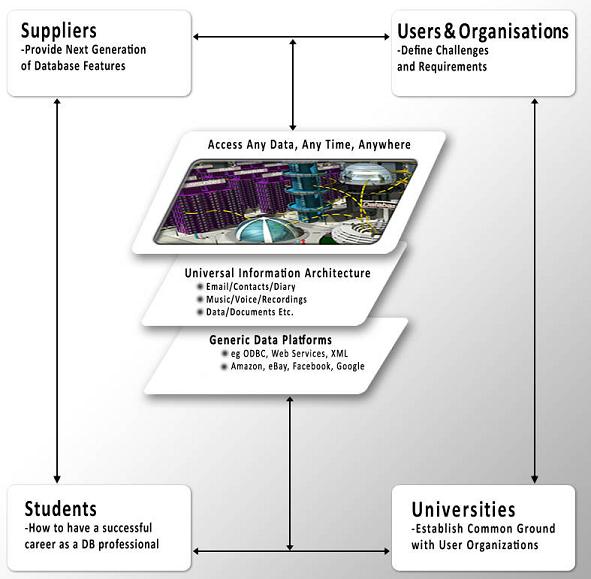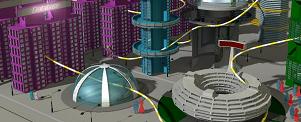|
|
 |

 |
|
 |
 |
| |
 |
 |
 The underlying Data Model is shown on another page.
The underlying Data Model is shown on another page.
This Architecture supports our Vision of the Future of Databases, and you can check out our Presentations.
We define Generic Data Platforms as Data Abstraction Layers which are associated with Data Services to perform CRUD functions.
Two typical Data Abstraction Layers We can identify a need for are a Transaction Data Layer and a Data Mart Layer.
Microsoft has established a
'Single View Platform' for Government.
This Vision brings up some very interesting challenges, such as how to design and build a Transformation Framework to go from Concept to Specifications.
Here is an example for IBM, and
one for Microsoft.
We have signed up with a very interesting
LinkedIn Group on
SOA Data Integration Architecture.
The diagram on the left shows planning for my Vision of the Future of Databases, as seen from four different perspectives :-
Suppliers
Suppliers will add features to meet the Requirements of Users and Organisations.
Users and Organisations
Users and Organisations will be establishing their Requirements to guide Suppliers.
Universities
Universities will be addressing significant areas of Research.
Students
Students will need guidance in planning successful Careers as Database professionals.
The Background
I have been a Database specialist for over 15 years.
The diagram on the left shows things that we might be involved in if we
live in a typical Community.
Each of these things will usually be supported by a Database, which is always
invisible and so we are never aware of it or its importance.
From time to time I read comments like :-
'... of course, Databases are very dry and boring.'.
I don't find them dry and boring (of course) and I am looking for a way to show this in a
way that anybody could understand.
I think the best way to do this is to ask creative and artistic people to come up with
a picture or image of the future in 10 or 20 years time showing how databases (and the
technology that uses them) will be everywhere, and what shape the technology could take.
Maybe these people have a well-developed right-hand side to their brains and I have only the left-hand side ?
Right now, we are familiar with a variety of portable devices and distribution media - Cell/Mobile Phones, iPods, PDAs, DVD players, and so on.
My personal prediction is that in less than 10 years everybody will have a portable device which will have free Internet access
with universal wireless acess, which they will carry everywhere - just like everybody else - giving new meaning to -
'Don't leave home without it'.
Or maybe we will have chips embedded in our brains to listen to our choice of free music from 'GoogleMusicAnywhere', with adverts that
reflect our personal interests.
Then the challenge is to create an image that shows this kind of future with some people in their daily lives.
Here's a summary of my thinking ...
A. In 2008, the current Situation offers the following facilities ...
A.1 Voice-activated PDAs ('Personal Digital Assistants')
These allow you to say things like 'Phone the Doctor' and the PDA will place the call
A.2 Touch-sensitive PDAs, eg the Apple iPhone
A.3 PDAs with Internet access, GPS, camera, with audio and video recording
A.4 Twitter and Twittervision can display our minute-by-minute movements
A.5 The Pandora Web Site will create a personalised Music Station just for you.
A.6 Yesterday I saw an ad for a package of Samsung (Cellphone manufacturer), Oyster (combined ticket for Bus, Train and Subway in London)
and Orange (Network Provider).
It won't be long before the Cell/Mobile phone has the functionality of Tickets and can be scanned by a barrier machine.
A.7 Today it was announced that Parking violations were being monitored by officials with head-mounted Video cameras.
B. In 2017, the medium-term Future might look like this ...
B.1 Wi-Fi will be available to everyone everywhere.
B.2 We will be able to say 'Make an Appointment with my Doctor', or 'Pay this Bill' and it will happen.
B.3 We will have portable around-the-clock devices.
These will be extended PDAs with will transmit GPS of our locationa and movements
B.4 Something like 'GoogleMusicEverywhere' will play music 24x7 according to how we feel.
We can say 'I feel romantic' or 'I want to party' and it will play music to suit our mood.
C. In 2027, the long-term Future might look like this ...
C.1 We will be able to visualise one of our Bills and think or say 'Pay that Bill'.
and the payment will automatically be made.
C.2 We will be able to have chips implanted in our brains to make telepathy possible to
fetch data from databases.
I think I should stop here because I don't want to give you my views - I am keen to hear your views.
We are looking for a futuristic version of the diagram at the top of the page which illustrates aspects of living in a community.
My current work for local government in London involves a Project with a team of people who patrol the streets, checking on overall cleanliness and specifically, aspects of 'envirocrime', such as Graffiti, Ltter and Abandoned Vehicles.
They use PDAs to send details of specific observations to a central Database and are then displayed on a Map of the area, and
Hot spots are identified.
You can download a
Zipped version (240k) or a
Microsoft Word version(290k) of an earlier description of this Grand Award.
I have updated this page more recently than the downloads.
Right now, we take for granted the Databases and Technology that are all around us.
For example, a Playlist on an iPod is a Database and the iPod is always with us.
Books at Amazon, eBay Bids and Menus at Starbucks are other examples of Databases that we use in our daily lives, usually without giving it a second thought.
It's interesting to consider the future evolution of Microblogging Sites, like Jaiku, Moodgeist, Mozes, Radar.net, Tumblr and Twitter.
An entertaining variation is TwitterVision which display in realtime where people are around the world and what they are doing.
And what about Social Networking web sites, like MySpace and YouTube ?
Wired magazine reports that a well-respected scientist called Gordon Bell is involved in a 'Lifestyle' experiment called MyLifeBits on behalf of Microsoft.
This involves recording everything he does and says throughout the day as a permanent Life History.
This is a 'Database for Everything Personal'.
Although the project is still in the preliminary stages, Bell envisions MyLifeBits evolving into a database that would form part of the MS operating system.
The program would have both a practical and personal side: users could employ the system to record every bit of data relating to a business venture, for example, or to document every stage of their child's development.
"I like to think of it as an accurate surrogate brain," Bell said.
Someday in the future, a compulsive recorder could call up a single day in her life and get an hour-by-hour breakdown of what she did, said and saw.
This page on my Web Site lists over 600 Databases that I have created and gives an indication of the range of current applications of Databases.
The winning design will bring to life a combination of Technology for fun and entertainment.
We'd also like to see the aspects of express evolution explored.
In other words, how quickly will things change and will some changes generate more changes more quickly and so on ?
The key question is 'How will Technology and Databases affect daily life for the young people in this diagram in 10 to 20 years time ?'

The image on the left is from an interesting article in Time Magazine on
'Data Addiction and the Hyperconnected'.
The article discusses the impact of Blackberries and the new Apple iPhones as examples of Personal Digital Assistants,(PDAs).
It defines the new term of 'Data Addiction' as 'the ceaseless craving for digital stimulation that contemporary technology is creating in us'.
It mentions Twitter which lets you broadcast, (on phone, IM or Internet), minute-by-minute
details of where you are and what you are doing.
|
|
|

